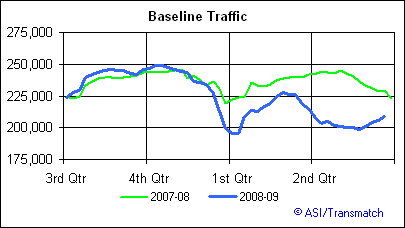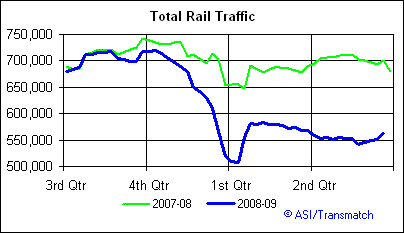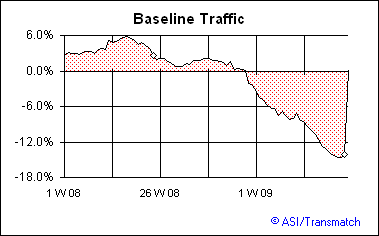Several weeks ago I took a very prominent blogger to task for making use of a 13 week moving year-over-year average of rail traffic data, comparing data from mid-March to mid-June 2009, to that of mid-March to mid-June 2008, to claim that rail traffic was "horrible" and "13-week moving averages are still moving lower, with no apparent end in sight."
In other words, this blogger was taking a very lagging trend and using it to predict worse coincident data in the future.
I countered that the 4 week moving averages of present traffic were a far more reliable statement of the present, and could portend a rise in the future, saying "It is certainly too soon to say that is a trend, but it could be the beginning of one, and if that is the case, then the lagging indicator of the 13 week year-over-year average cited by that prominent blogger will abruptly begin to rise - a couple of months from now."
Well, the present trend has continued. Look at the following graph of baseline rail traffic (all graphs reposted from Railfax), showing a clear increase in the last couple of months (note to gloomsters, this is not a second derivative "less worse" statistic, it is an absolute "better" number):

and here is the same 4 week moving average for total traffic (which also includes cyclical and intermodal cars):

And lo and behold, look what has just happened to the 13 week year over year moving average of baseline rail traffic: it has just started to rise.

No guarantees of course, but if leading indicators are correct, the coincident indicator of rail traffic should continue to improve, and in that case not only will the 4-week moving average continue to improve, but baseline rail traffic this year could actually surpass last year's activity in a couple of months.
The use of badly lagging data to project trends into the future is endemic in the economic blogosphere. Just yesterday I read another very prominent economic post that consisted almost entirely of projecting year-over-year percentage changes into the future to foretell economic Armageddon -- a classic case of driving by looking in the rear view mirror.